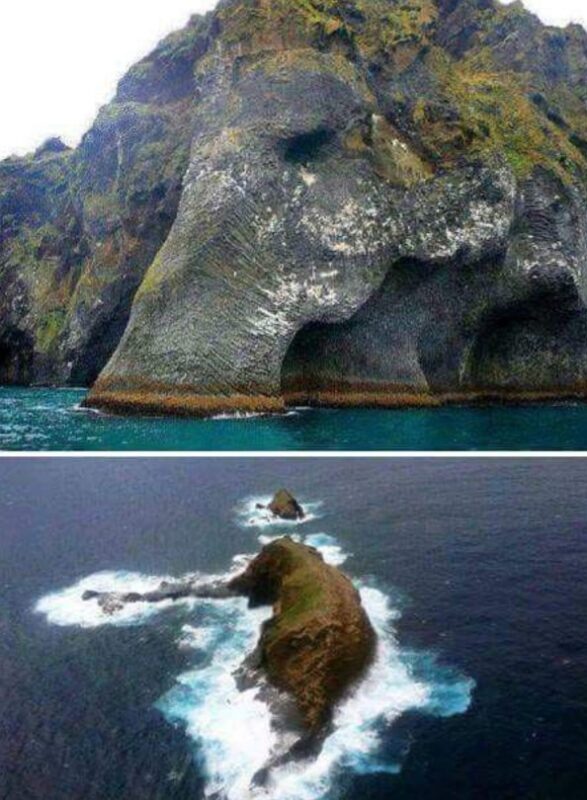These sites feature Hawaii’s Elephant Rock, elephant-like rock formations shaped by volcanic activity and the relentless forces of nature over millennia. While they are separated by vast oceans, these geological wonders share a connection through their resemblance to the majestic elephant, symbolizing strength and endurance. Follow archeology.dulichvn.net to learn more about the art of nature.
Hawaiis Elephant Rock volcanic Elephant
The Rugged Beauty of Homey
Heimaey, part of the Westman Islands off Iceland’s southern coast, is known for its dramatic volcanic landscape. Towering cliffs carved by centuries of eruptions rise sharply from the ocean, creating a surreal and rugged terrain. The dark basalt rock contrasts with patches of green moss, highlighting the island’s untamed beauty.

Formation of the Elephant Rock
Among Heimaey’s stunning features is its iconic Elephant Rock, a natural formation that resembles an elephant with its trunk dipping into the sea. This unique shape is the result of ancient lava flows solidifying into basalt, combined with centuries of wind and wave erosion sculpting the rock into its current form.
A Symbol of Iceland’s Geological Power
Elephant Rock is more than just a geological curiosity; it represents the raw power of Iceland’s volcanic activity. The island itself was shaped by the eruption of Eldfell in 1973, which dramatically altered Heimaey’s landscape. Today, the rock formation stands as a testament to the island’s fiery origins and natural resilience.
See more: Standing Tall The Story of Redwood Trees and Their Timeless Beauty
Mokuhooniki: Hawaiis Elephant Rock
The Tropical Charm of Mokuhooniki
Mokuhooniki, a small islet near Molokai in Hawaii, captivates visitors with its pristine beauty. Surrounded by crystal-clear waters, this volcanic island is a haven for marine life and a popular spot for snorkeling and diving. Its remote location adds to its allure, making it a hidden gem in Hawaii’s archipelago.

The Elephant Rock of Mokuhooniki
Hawaii’s Elephant Rock is a striking natural sculpture formed by ancient lava flows and the unyielding power of the ocean. Its shape, resembling an elephant with its trunk extending into the water, is a result of weathering and erosion over thousands of years. This formation is a stunning example of nature’s ability to create recognizable shapes from raw materials.
A Reflection of Hawaii’s Volcanic Heritage
The Elephant Rock in Mokuhooniki reflects Hawaii’s rich volcanic history. Like the rest of the islands in the Hawaiian chain, it was born from volcanic activity. The rock formation serves as a reminder of the island’s fiery origins and the beauty that can emerge from destruction.
See more: The Shell Grotto in Margate An Underground Enigma of Shells
Comparing the Elephant Formations
Similarities in Geological Origins
Both Heimaey and Mokuhooniki’s elephant-like rock formations share volcanic origins. Their unique shapes were sculpted by a combination of lava flows, erosion, and natural weathering, showcasing the creative power of geological processes.

Cultural and Natural Significance
While these formations are natural phenomena, they carry cultural and symbolic significance. Elephants are often associated with strength, wisdom, and resilience, qualities reflected in the enduring nature of these rocks.
Diverse Backdrops and Ecosystems
Despite their similarities, the settings of these formations differ greatly. Heimaey’s Elephant Rock is surrounded by Iceland’s cold, rugged cliffs and dramatic volcanic landscapes, while Mokuhooniki’s Elephant Rock is framed by Hawaii’s warm, tropical waters and vibrant marine ecosystems.
Visiting These Geological Marvels
Exploring Heimaey in Iceland
Visitors to Heimaey can take a boat tour around the island to see Elephant Rock up close. The journey offers breathtaking views of the cliffs and the chance to experience the island’s unique wildlife, including puffins and seals. Hiking enthusiasts can also explore the remnants of Eldfell volcano, adding an adventurous twist to their visit.

Discovering Mokuhooniki in Hawaii
Mokuhooniki is best accessed by boat or kayak, making it a favorite destination for adventurous travelers. Snorkeling and diving around the islet provide a chance to witness Hawaii’s vibrant marine life, while the Elephant Rock formation itself is a must-see for nature lovers and photographers.
Respecting Nature’s Masterpieces
Both sites are fragile ecosystems that require careful preservation. Visitors are encouraged to respect local guidelines, avoid littering, and appreciate these formations from a safe distance to ensure they remain intact for future generations.
The Symbolism of Elephant Rock Formations
Nature’s Sculptural Genius
The resemblance of these formations to elephants highlights nature’s ability to create art from chaos. Through volcanic eruptions and erosion, the Earth has sculpted shapes that resonate with human imagination.

A Connection to Endurance
Elephants are symbols of endurance, wisdom, and strength, qualities mirrored in these rock formations. They stand as reminders of the enduring power of nature and the resilience of the planet’s landscapes.
Inspiration for Conservation
These formations inspire awe and underscore the importance of preserving natural wonders. By valuing and protecting sites like Heimaey and Mokuhooniki, humanity can ensure that these geological masterpieces continue to inspire future generations.
Conclusion: Celebrating Earth’s Creativity
The Hawaiis Elephant Rock in Iceland and Mokuhooniki are extraordinary examples of nature’s creativity and resilience. Born from volcanic activity and shaped by time, these formations not only captivate with their beauty but also symbolize the enduring power of the natural world.
Visiting these sites is a journey into Earth’s geological past, offering an opportunity to marvel at the artistry of erosion and the legacy of ancient volcanoes. Whether standing on the rugged cliffs of Heimaey or floating in the tranquil waters of Mokuhooniki, these elephant rocks remind us of nature’s boundless ability to surprise and inspire.


CÁC TIN KHÁC
Mary Walton: The Forgotten Inventor Who Helped Clean Up America’s Cities
Tomb of Queen Nefertari in the Valley of the Queens, Egypt
Discover the Hypostyle Hall of the Temple of Hathor at Dendera
Venus de Losange: Unveiling the Mystery of a 20,000-Year-Old Paleolithic Icon